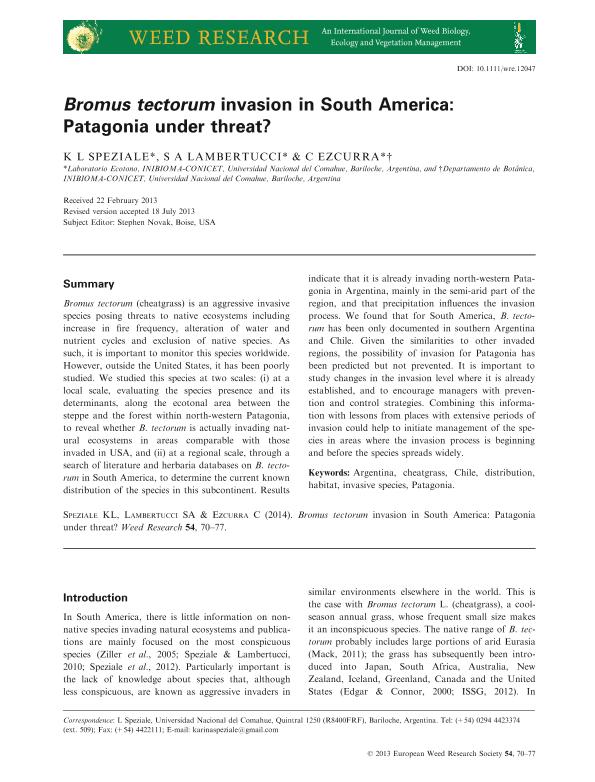Artículo
Bromus tectorum invasion in South America: Patagonia under threat?
Fecha de publicación:
02/2014
Editorial:
Wiley Blackwell Publishing, Inc
Revista:
Weed Research
e-ISSN:
1365-3180
Idioma:
Inglés
Tipo de recurso:
Artículo publicado
Clasificación temática:
Resumen
Bromus tectorum (cheatgrass) is an aggressive invasive species posing threats to native ecosystems including increase in fire frequency, alteration of water and nutrient cycles and exclusion of native species. As such, it is important to monitor this species worldwide. However, outside the United States, it has been poorly studied. We studied this species at two scales: (i) at a local scale, evaluating the species presence and its determinants, along the ecotonal area between the steppe and the forest within north-western Patagonia, to reveal whether B. tectorum is actually invading natural ecosystems in areas comparable with those invaded in USA, and (ii) at a regional scale, through a search of literature and herbaria databases on B. tectorum in South America, to determine the current known distribution of the species in this subcontinent. Results indicate that it is already invading north-western Patagonia in Argentina, mainly in the semi-arid part of the region, and that precipitation influences the invasion process. We found that for South America, B. tectorum has been only documented in southern Argentina and Chile. Given the similarities to other invaded regions, the possibility of invasion for Patagonia has been predicted but not prevented. It is important to study changes in the invasion level where it is already established, and to encourage managers with prevention and control strategies. Combining this information with lessons from places with extensive periods of invasion could help to initiate management of the species in areas where the invasion process is beginning and before the species spreads widely.
Palabras clave:
Argentina
,
Cheatgrass
,
Invasive Species
,
Patagonia
Archivos asociados
Licencia
Identificadores
Colecciones
Articulos(INIBIOMA)
Articulos de INST. DE INVEST.EN BIODIVERSIDAD Y MEDIOAMBIENTE
Articulos de INST. DE INVEST.EN BIODIVERSIDAD Y MEDIOAMBIENTE
Citación
Speziale, Karina Lilian; Lambertucci, Sergio Agustin; Ezcurra, Cecilia; Bromus tectorum invasion in South America: Patagonia under threat?; Wiley Blackwell Publishing, Inc; Weed Research; 54; 1; 2-2014; 70-77
Compartir
Altmétricas




